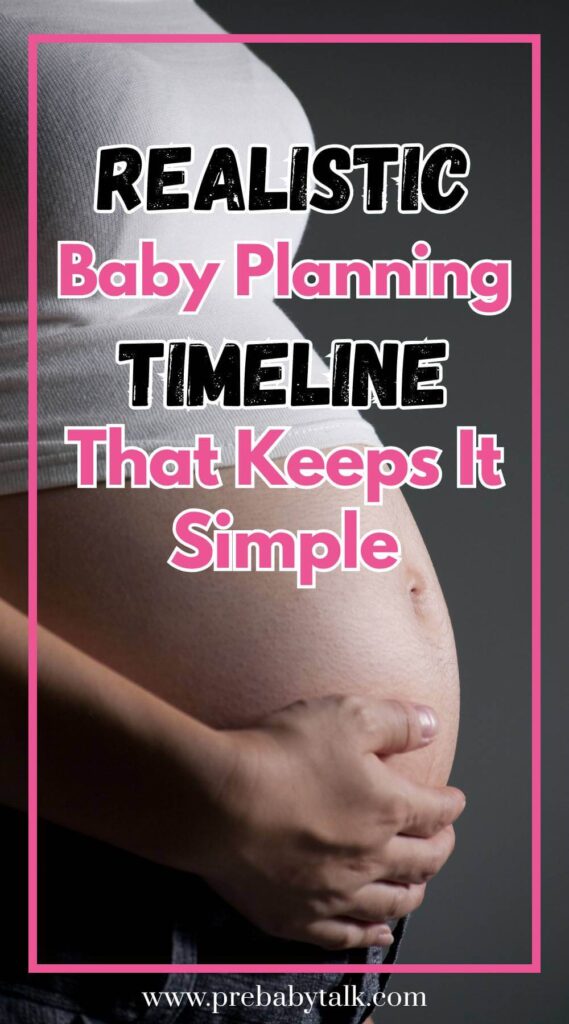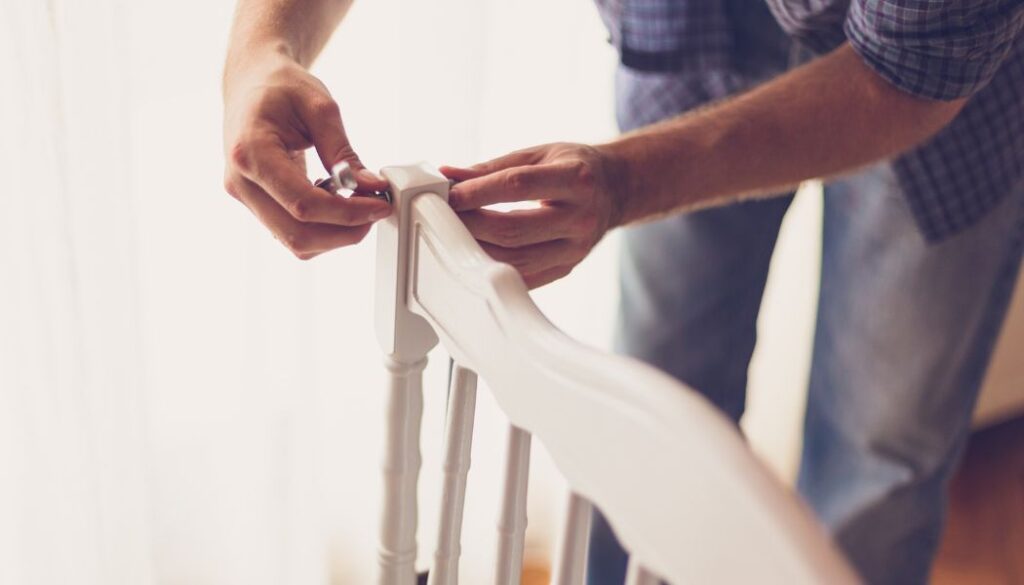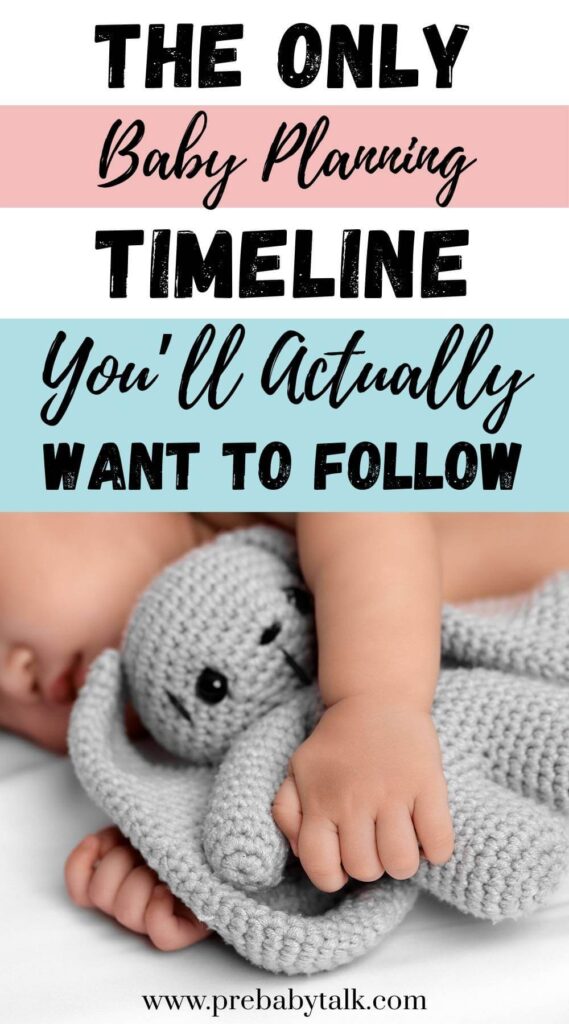This post shows you the real and realistic baby planning timeline that tells you a bit more than what you’ll find in baby tracking apps!
I genuinely believe proper baby planning starts years before you have a baby because one of the most important things is preparing your body, mind, and soul to welcome a gorgeous little human.

But it’s not just about you. You need to prepare your home, your relationship, your work, and even your pet! And when the time comes, you’ll be facing some of the biggest changes you’ve ever imagined.
Let me tell you, as someone writing this at 8 months pregnant, it’s less scary than you’d think. That’s why I’m sharing a realistic baby planning timeline and what to expect each month!
3 to 6 Months Before You Get Pregnant
There are so many things you can do before you get pregnant to make your journey easier and more relaxing!
Get Moving and Start Exercising – 6 Months Before
The first thing I’d suggest is to start moving. Start walking daily, get your steps in, do light exercise, and stretch!
You can try yoga or Pilates at home and check out some YouTube channels (like Grow With Jo) where you can learn how to exercise and actually enjoy it!
Movement isn’t just about burning calories. It’s about preparing your body for the pregnancy journey.
Your partner should jump on the wagon as well! You both need to be physically fit (this has nothing to do with appearance) and ready.
Schedule Your Yearly Health Checkups – 3 Months Before
Then, you should schedule all of your health checkups, especially if you have a chronic condition that needs managing, and do your regular yearly examination at your doctor’s office just to see if everything is okay. I mean, why wouldn’t it be? But still, it’s better to know now.
I went to see a cardiologist before I got pregnant, knowing that the heart has to pump 40% more blood during pregnancy!
I also went to the dentist for a yearly checkup, knowing that dental procedures aren’t exactly comfortable once you’re pregnant.
Start Baby Planning With Your Partner – 3 to 6 Months Before

I think every couple should decide if they’re ready to have kids before they start baby planning.
While no one is ever fully ready, and we all embrace change without knowing exactly what to expect, I think it’s important to sit together and figure out if you’re truly ready to have a child.
There are some questions that could completely shift how you approach parenthood—have you asked them yet?
If not, start talking about whether you’re truly ready for kids. You can use my “blueprint“ and see if there’s something you haven’t talked about before!
Start Taking Prenatal Vitamins – 3 Months Before
This one’s essential. Start taking prenatal vitamins at least 3 months before trying to conceive, since folic acid takes time to build up in your system, around three months to reach optimal levels.
First Trimester (Weeks 1–13)
The first trimester is the hardest. It’s even harder than the third.
And let me tell you why:
- nausea
- hormone changes
- anxiety
I honestly don’t know which is worse, but if I had to pick one, it’s definitely the anxiety.
I really recommend that you use a good app (that won’t steal your data) to track your pregnancy. Or even better, find a reliable source (like What to Expect) and read about symptoms each week.
Then, I really suggest staying off social media. I was so anxious during my first months of pregnancy because my TikTok was full of negativity.
Then there’s the creepy algorithms, where I was almost convinced that every pregnancy ends in a loss the first time.
But it’s not like that.
1 out of 4 does, and it’s usually for a “good” reason: something is seriously wrong with the baby, and it wouldn’t be able to survive.
To help you stay sane, I suggest:
- reading only official guidelines
- taking your prenatal vitamins
- talking and snuggling with your partner
- staying off social media
- using the Pregnancy Reassurer website, which kept every woman sane
Medical Appointments (Weeks 1–13)

There are 3 main medical appointments you need to take.
Depending on where you are, you may only have one or two, but that’s also okay.
The first prenatal visit is around weeks 6 – 8. At this appointment, your doctor will be able to confirm the pregnancy!
Since it’s between weeks 6-8, you’ll be able to hear the baby’s heartbeat!
If you look at the screen while having an ultrasound, you’ll see a small flicker of black and white light. When I saw it, I thought it looked like a Christmas light flickering.
Along with the ultrasound, you’ll have your first blood tests. You can expect:
- to determine your blood type and Rh factor
- screen for anemia and do complete bloodwork including cholesterol and glucose levels
- if you haven’t done STD tests in the last 3-6 months, you are going to do them now
- urine tests to check the protein levels
And the most important part for you is that your doctor will calculate the due date for you.
Then, you can have some fun and use the Chinese Gender Predictor. It was accurate for me (it told me it would be a girl!), but of course, don’t take it seriously! It’s only there to have some fun!
If you decide to do the optional NIPT screening, you will find out your baby’s gender in the first trimester!
Screenings: NT and NIPT
While all these screenings in the first trimester are optional, I suggest you talk to your doctor and make the most out of them because they can help you learn more about your baby and give you peace of mind!
NT Scan (Nuchal Translucency)
While a lot of people don’t do the NT scan (Nuchal Translucency) anymore — it’s considered outdated and not that accurate — I still wanted to get it done.
My insurance covered it, and even though I knew the accuracy was between 80 and 85%, that ultrasound was important for me because it was done in a hospital and not by my local OB.
The NT scan is often called a combined scan because it takes your bloodwork to check for chromosomal abnormalities and then puts the results into a computer that uses statistics to estimate the odds of something being wrong.
Then there’s the ultrasound part, where they check for the nasal bone’s presence and measure the nuchal fold’s thickness.
NIPT (Non-Invasive Prenatal Testing)

Another optional scan is the NIPT (Non-Invasive Prenatal Testing). Where I am, this one can cost between $500 and $1500, depending on what you want to test.
It is generally something recommended for women over 35 years of age, but honestly, it is totally optional.
I wanted to take it, though, and the money for the NIPT was something I had been saving for a while, as I really wanted to do it.
I did it when I was 11 weeks pregnant, and I knew that I would have a good fetal fraction by then. That means there is enough of the baby’s DNA to be taken from my blood!
This is why it is called a non-invasive test, as it only takes the mom’s blood to check for the most common chromosomal abnormalities.
You will also find out your baby’s gender if you do the NIPT!
Just remember, if something comes back high-risk, it does not mean something is definitely wrong. You would need further diagnostic testing, like amniocentesis, to confirm it.
Second Trimester (Weeks 14–27)
The second trimester is the best one! If you’re lucky, there will be no more nausea, your appetite will be back, and your tummy won’t be that big, so you’re still going to be super comfortable!
Then, there’s the excitement that comes with the baby announcement, gender reveal, and telling the whole world that you’re expecting a baby.
When it comes to a baby planning timeline, you can expect the most important ultrasound appointment to keep up with your prenatal vitamins and to enjoy the best three months of your pregnancy!
The best part about the second trimester is the first baby kicks! I had mine at 26 weeks because I had an anterior placenta, but you may get them earlier or later! It’s all normal, and it’s all good! Baby kicks are going to be super exciting!
Medical Appointments (Weeks 14–27)
Please remember that depending on where you live, your medical history, and your health conditions, you may have more or fewer medical appointments than the ones I’m going to mention. And it’s all okay, as long as you keep on making informed decisions with your doctor!
- You’re going to have regular checkups every 4-6 weeks, where they are going to do an ultrasound, listen to the baby’s heartbeat, and measure their progress. Sometimes, you’re only going to have one ultrasound in the second trimester, and that’s also okay!
- You’re going to have to do more urine tests and bloodwork to check your overall health.
The most important appointment will be your anatomy scan! The anatomy scan is usually scheduled in weeks 22-24, and it’s a very detailed ultrasound exam where a doctor checks your baby’s progress.
Expect to hear about:
- baby’s size, head, femur length
- your placenta, position, and amniotic fluid levels
- everything about your baby’s heartbeat and oxygen flow
This test is very important, as doctors can detect any anomalies and send you for additional tests or simply schedule more appointments just to follow you closely and see how your baby is developing.
Then there’s the glucose screening test, usually scheduled between weeks 24-28. This is a routine test, but not everyone will have it!
I didn’t have one, although I was sure that I would have to take it. However, as my doctor explained, they test for blood glucose levels after fasting regularly (every month), and they test for protein in urine. They also check the amniotic fluid levels and baby size on the ultrasound. If these four are not optimal, then they will schedule the test.
However, it may be different for you, and please, if it is, don’t panic, as it’s all super, super normal. It just depends on your hospital policy, your doctor, your state, and your overall health.
The last thing you may do is get a Rh immunoglobulin shot around weeks 28-30.
Second Trimester Baby Planning Timeline Beyond the Doctors

Now, when it comes to how you’re feeling in the second trimester and what you should do during these lovely three months, I suggest taking some time to relax and enjoy being with your partner.
If you’re looking for inspiration, check out my second-trimester date ideas! They’re perfect for couples who want to make their pregnancy the best time of their lives. So have a look and plan something fun together!
Besides having fun and relaxing, you’ll also want to get a few things done. Now, before you jump down my throat, let me explain what I mean.
Talk to your employer about how your maternity leave will work.
Ask if there are options for going hybrid or working from home.
Talk to your partner about whether you can afford to take more time off.
Explore all your options, and never be too shy or modest to communicate your needs! Work doesn’t come first. You and your baby do!
Third Trimester (Weeks 28–40) Baby Planning Timeline
This is where things get real! Your tummy will start to grow, and the baby will be moving so much that you’ll know her rhythm by heart!
If you haven’t started already, now’s the time to dive into baby shopping!
Don’t wait until you’re 9 months pregnant. It gets a lot harder to move around, browse shops, and make important decisions when all you really want to do is lie down and rest.
One of the best parts of the third trimester is baby shopping! It’s so much fun to pick out tiny clothes, cute socks, and your baby’s very first blanket!
I’m doing this with my husband—come join in too! Here’s how to save money while getting everything you need. I put together an underconsumption-based baby shopping list for anyone who doesn’t want to get swept up in vanity, consumerism, and societal trends that really don’t benefit the baby!
Third Trimester Medical Appointments

You can expect more checkups and visits in the third trimester as your doctors want to monitor:
- your baby’s growth
- their position and whether it is changing
- your weight and blood pressure, just to make sure that you’re progressing nicely
You can still relax a bit between weeks 28-36, as you probably don’t need to worry about preterm labor during this period.
Now would be a really good time to pack your hospital bag! It should be ready and packed so that if you need to go to the hospital in the middle of the night, you’re all set.
Once you approach week 36, things will start to get real.
You may experience your first cervical check around this time. It’s the most unpleasant thing in the world, but it’s necessary, as they check for dilation and effacement.
Dilation is how open your cervix is, and it goes from 0cm (normal, aka closed) to 10cm (you need to push the baby ASAP).
You can be 1cm open and still be sent home to wait a couple of days. It’s not that big of a deal if it’s slightly open, just so you know.
Effacement is measured in percentages, and it shows how thin and stretchy your cervix is so you can push the baby out.
You can also expect a group B Streptococcus (GBS) test between weeks 36-38. It’s a little bit weird, as they will do a swab up your bum. But it’s okay, you’ll live.
Ah, the things we women do for babies and life.
Have a birth plan ready in your third trimester. Print it out and have several spare copies. Keep one in your bag, and give one to your partner. Of course, you’re going to share your birth plan with your midwife and hospital staff.
Non-Stress Test (NST) After Week 36
This varies by state, location, and your condition, but you can also expect to have an NST or CTG, as some people call it (cardiotocography).
For example, where I am, this is done routinely at week 36.
It’s a pretty relaxing test (not stressful at all!), and all you need to do is lie down and relax. They will attach two monitors to your belly. One measures the baby’s heartbeat, and the other measures your contractions. It usually lasts between 20-30 minutes.
You can read a book, relax, scroll your phone, or just chill while they do this test.
Baby Planning Final Steps

Ah, there are so many final steps to take, and there’s always more to do.
But we covered the most important parts. Pack your hospital bag, have your birth plan ready, and have all your medical documentation with you.
Stay positive because soon you’re going to meet your baby!
When it comes to some additional steps, I suggest you:
- read the Pre-Baby Talk! No, honestly, I wrote about packing your hospital bag, preparing postpartum meals to freeze, and even made a cleaning checklist for before the baby comes!
- talk to your friends and family about visits, getting help, or just go for a coffee to relax a bit.
- make sure you dedicate a lot of time to your pets, as this will be a big change for them, so you should have the crib ready, bring home some baby stuff, including the stroller, so they get used to those new funny items!
37 Realistic Baby Planning Tips for Every Trimester (Medical + Non-Medical)
6 Months Before Pregnancy
- 6 Months Before: Start daily movement and light exercise (walking, yoga, Pilates)
- 6 Months Before: Have baby planning conversations with your partner
3 Months Before Pregnancy
- 3 Months Before: Start taking prenatal vitamins (build up folic acid levels)
- 3 Months Before: Schedule yearly health checkups (doctor, dentist, cardiologist if needed)
- 3 Months Before: Start gentle financial, emotional, and home prep
First Trimester (Weeks 1–13)
- Weeks 6–8: First prenatal visit (confirm pregnancy, ultrasound, hear heartbeat)
- Weeks 6–8: First blood work (blood type, Rh factor, anemia, glucose, cholesterol)
- Weeks 6–8: Urine tests and STD screenings (if not recently done)
- Weeks 6–13: Stay off negative social media (protect mental health)
- Weeks 6–13: Take prenatal vitamins daily
- Weeks 6–13: Use a reliable pregnancy app or resource (like What to Expect)
- Weeks 10–13: Optional NT scan (nuchal translucency ultrasound + bloodwork)
- Weeks 10–13: Optional NIPT test (find out baby’s gender early if desired)
Second Trimester (Weeks 14–27)
- Weeks 14–27: Regular checkups every 4–6 weeks (ultrasound, heartbeat, measurements)
- Weeks 14–27: Plan baby announcement or gender reveal
- Weeks 14–27: Keep taking prenatal vitamins
- Weeks 22–24: Anatomy scan (detailed ultrasound: baby’s size, heartbeat, placenta, fluid levels)
- Weeks 24–28: Glucose screening test (if needed)
- Weeks 24–28: Start creating a baby shopping list
- Weeks 24–28: Talk to your employer about maternity leave plans
- Weeks 24–28: Discuss hybrid/remote work options with employer
- Weeks 24–28: Discuss financial plans for taking extra time off
- Weeks 26–27: Feel first baby kicks (may vary, especially with anterior placenta)
Third Trimester (Weeks 28–40)
- Weeks 28–30: Rh immunoglobulin shot (if needed)
- Weeks 28–30: Begin serious baby shopping (clothes, socks, baby essentials)
- Weeks 28–36: Relax—preterm labor is usually not a concern yet
- Weeks 30–36: Pack your hospital bag (have it ready before 36 weeks)
- Weeks 30–36: Finalize your birth plan (print copies for bag, partner, hospital)
- Weeks 30–36: Set up the crib and bring baby items into the home for pets to adjust
- Weeks 30–36: Freeze postpartum meals if you want extra support after birth
- Weeks 36–38: Group B Streptococcus (GBS) test
- Weeks 36–38: Start cervical checks (dilation and effacement checks)
- Week 36: Non-Stress Test (NST) or CTG (monitor baby’s heartbeat and contractions)
- Weeks 36–40: Final hospital prep (double-check documents, bag, snacks, comfy clothes)
- Weeks 36–40: Stay positive, connect emotionally with your partner, and get ready to meet your baby!
Little Final Add-Ons
- At Any Time: Cuddle with your pets, talk to your baby, and enjoy this special season!
- At Any Time: Stay flexible—every pregnancy is different, and that’s okay.
Figuring out the baby planning timeline is a part of the Pre-Baby Talk. That’s why, when the baby comes, you’ll be ready and prepared for…
…all the love in the world.
Which of these events are you looking forward to the most? Let me know in the comments!
Don’t forget to pin this post so you’ll always have this timeline handy!

This post showed you the Realistic Baby Planning Timeline: What to Do Each Trimester.
You may also like:
Leave a Reply